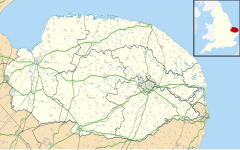Watton, Norfolk
| Watton | |
|---|---|
 Watton town sign |
|
| Watton shown within Norfolk | |
| Area | 7.20 km2 (2.78 sq mi) |
| Population | 7,202 (2011 census) |
| • Density | 1,000/km2 (2,600/sq mi) |
| OS grid reference | TF916008 |
| District | |
| Shire county | |
| Region | |
| Country | England |
| Sovereign state | United Kingdom |
| Post town | WATTON |
| Postcode district | IP25 |
| Dialling code | 01953 |
| Police | Norfolk |
| Fire | Norfolk |
| Ambulance | East of England |
| EU Parliament | East of England |
| UK Parliament | |
| Website | http://www.wattontowncouncil.gov.uk/ |
| Location | Norfolk |
|---|---|
| Proposer | Sustrans |
| Website | http://www.sustransconnect2.org.uk/schemes/project_detail.php?id=74 |
| Status | Proposed |
| Cost estimate | £250,000 |
Watton is a market town in the district of Breckland within the English county of Norfolk. The A1075 Dereham-Thetford road and the B1108 Brandon-Norwich Road meet at a crossroads here, where the town developed, about 25 miles (40 km) west of Norwich.
The civil parish covers an area of 7.2 km2 (2.8 sq mi) with about 6,800 inhabitants in 3,000 households, increasing to a population of 7,202 in 3,226 at the 2011 Census. The Domesday Book records that Watton (or Wadetuna) featured a church, manor house and Anglo-Saxon settlement.
In 1984 Watton was twinned with the Lower Rhine (Niederrhein) town of Weeze, Germany, with the subsequent twinning charter being formally signed in 1987.
A market is held every Wednesday, between 9.00am and 1.00pm, although stalls are often kept open on the high street well after this time. Like many Norfolk markets, Watton market always has a wide variety of fresh sea produce available, usually caught the previous day. It often has available such regional delicacies as samphire and fresh water crayfish. The Lord of Watton Hall, John de Vaux, obtained a charter for a market to be held on Fridays. But, the people of nearby Saham Toney complained to the King that the market was harming their own held on the same day. Their complaints were upheld and the charter was withdrawn.
John de Vaux conveyed the manor to his brother Oliver, who was evidently on better terms with the King since he immediately obtained a new charter for a Wednesday market. The market centred on Market Square in front of Wayland Hall, and as it grew it spread westwards along High Street. A market cross stood in the square supported by eight oak pillars. This cross was demolished in 1820 and replaced by a milestone showing the distances to neighbouring towns.
...
Wikipedia

